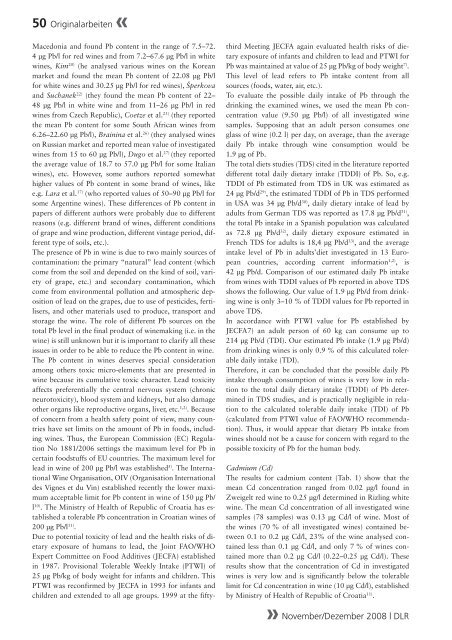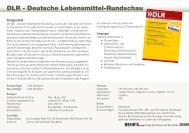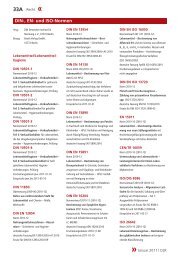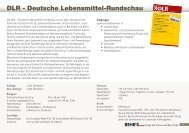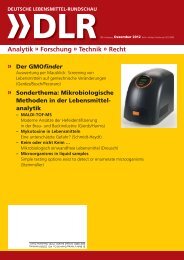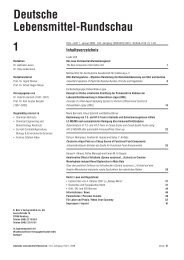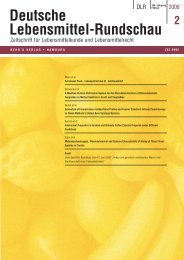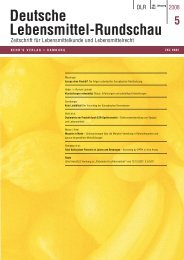Nanotechnologie in Lebensmitteln - DLR Online: Deutsche ...
Nanotechnologie in Lebensmitteln - DLR Online: Deutsche ...
Nanotechnologie in Lebensmitteln - DLR Online: Deutsche ...
Sie wollen auch ein ePaper? Erhöhen Sie die Reichweite Ihrer Titel.
YUMPU macht aus Druck-PDFs automatisch weboptimierte ePaper, die Google liebt.
50<br />
Orig<strong>in</strong>alarbeiten «<br />
Macedonia and found Pb content <strong>in</strong> the range of 7.5–72.<br />
4 μg Pb/l for red w<strong>in</strong>es and from 7.2–67.6 μg Pb/l <strong>in</strong> white<br />
w<strong>in</strong>es, Kim 20) (he analysed various w<strong>in</strong>es on the Korean<br />
market and found the mean Pb content of 22.08 μg Pb/l<br />
for white w<strong>in</strong>es and 30.25 μg Pb/l for red w<strong>in</strong>es), Šperkova<br />
and Suchanek 22) (they found the mean Pb content of 22–<br />
48 μg Pb/l <strong>in</strong> white w<strong>in</strong>e and from 11–26 μg Pb/l <strong>in</strong> red<br />
w<strong>in</strong>es from Czech Republic), Coetze et al. 23) (they reported<br />
the mean Pb content for some South African w<strong>in</strong>es from<br />
6.26–22.60 μg Pb/l), Bra<strong>in</strong><strong>in</strong>a et al. 26) (they analysed w<strong>in</strong>es<br />
on Russian market and reported mean value of <strong>in</strong>vestigated<br />
w<strong>in</strong>es from 15 to 60 μg Pb/l), Dugo et al. 27) (they reported<br />
the average value of 18.7 to 57.0 μg Pb/l for some Italian<br />
w<strong>in</strong>es), etc. However, some authors reported somewhat<br />
higher values of Pb content <strong>in</strong> some brand of w<strong>in</strong>es, like<br />
e.g. Lara et al. 17) (who reported values of 50–90 μg Pb/l for<br />
some Argent<strong>in</strong>e w<strong>in</strong>es). These differences of Pb content <strong>in</strong><br />
papers of different authors were probably due to different<br />
reasons (e.g. different brand of w<strong>in</strong>es, different conditions<br />
of grape and w<strong>in</strong>e production, different v<strong>in</strong>tage period, different<br />
type of soils, etc.).<br />
The presence of Pb <strong>in</strong> w<strong>in</strong>e is due to two ma<strong>in</strong>ly sources of<br />
contam<strong>in</strong>ation: the primary “natural” lead content (which<br />
come from the soil and depended on the k<strong>in</strong>d of soil, variety<br />
of grape, etc.) and secondary contam<strong>in</strong>ation, which<br />
come from environmental pollution and atmospheric deposition<br />
of lead on the grapes, due to use of pesticides, fertilisers,<br />
and other materials used to produce, transport and<br />
storage the w<strong>in</strong>e. The role of different Pb sources on the<br />
total Pb level <strong>in</strong> the f<strong>in</strong>al product of w<strong>in</strong>emak<strong>in</strong>g (i.e. <strong>in</strong> the<br />
w<strong>in</strong>e) is still unknown but it is important to clarify all these<br />
issues <strong>in</strong> order to be able to reduce the Pb content <strong>in</strong> w<strong>in</strong>e.<br />
The Pb content <strong>in</strong> w<strong>in</strong>es deserves special consideration<br />
among others toxic micro-elements that are presented <strong>in</strong><br />
w<strong>in</strong>e because its cumulative toxic character. Lead toxicity<br />
affects preferentially the central nervous system (chronic<br />
neurotoxicity), blood system and kidneys, but also damage<br />
other organs like reproductive organs, liver, etc. 1,2) . Because<br />
of concern from a health safety po<strong>in</strong>t of view, many countries<br />
have set limits on the amount of Pb <strong>in</strong> foods, <strong>in</strong>clud<strong>in</strong>g<br />
w<strong>in</strong>es. Thus, the European Commission (EC) Regulation<br />
No 1881/2006 sett<strong>in</strong>gs the maximum level for Pb <strong>in</strong><br />
certa<strong>in</strong> foodstuffs of EU countries. The maximum level for<br />
lead <strong>in</strong> w<strong>in</strong>e of 200 μg Pb/l was established 5) . The International<br />
W<strong>in</strong>e Organisation, OIV (Organisation International<br />
des Vignes et du V<strong>in</strong>) established recently the lower maximum<br />
acceptable limit for Pb content <strong>in</strong> w<strong>in</strong>e of 150 μg Pb/<br />
l 10) . The M<strong>in</strong>istry of Health of Republic of Croatia has established<br />
a tolerable Pb concentration <strong>in</strong> Croatian w<strong>in</strong>es of<br />
200 μg Pb/l 11) .<br />
Due to potential toxicity of lead and the health risks of dietary<br />
exposure of humans to lead, the Jo<strong>in</strong>t FAO/WHO<br />
Expert Committee on Food Additives (JECFA) established<br />
<strong>in</strong> 1987. Provisional Tolerable Weekly Intake (PTWI) of<br />
25 μg Pb/kg of body weight for <strong>in</strong>fants and children. This<br />
PTWI was reconfirmed by JECFA <strong>in</strong> 1993 for <strong>in</strong>fants and<br />
children and extended to all age groups. 1999 at the fifty-<br />
third Meet<strong>in</strong>g JECFA aga<strong>in</strong> evaluated health risks of dietary<br />
exposure of <strong>in</strong>fants and children to lead and PTWI for<br />
Pb was ma<strong>in</strong>ta<strong>in</strong>ed at value of 25 μg Pb/kg of body weight 7) .<br />
This level of lead refers to Pb <strong>in</strong>take content from all<br />
sources (foods, water, air, etc.).<br />
To evaluate the possible daily <strong>in</strong>take of Pb through the<br />
dr<strong>in</strong>k<strong>in</strong>g the exam<strong>in</strong>ed w<strong>in</strong>es, we used the mean Pb concentration<br />
value (9.50 μg Pb/l) of all <strong>in</strong>vestigated w<strong>in</strong>e<br />
samples. Suppos<strong>in</strong>g that an adult person consumes one<br />
glass of w<strong>in</strong>e (0.2 l) per day, on average, than the average<br />
daily Pb <strong>in</strong>take through w<strong>in</strong>e consumption would be<br />
1.9 μg of Pb.<br />
The total diets studies (TDS) cited <strong>in</strong> the literature reported<br />
different total daily dietary <strong>in</strong>take (TDDI) of Pb. So, e.g.<br />
TDDI of Pb estimated from TDS <strong>in</strong> UK was estimated as<br />
24 μg Pb/d 29) , the estimated TDDI of Pb <strong>in</strong> TDS performed<br />
<strong>in</strong> USA was 34 μg Pb/d 30) , daily dietary <strong>in</strong>take of lead by<br />
adults from German TDS was reported as 17.8 μg Pb/d 31) ,<br />
the total Pb <strong>in</strong>take <strong>in</strong> a Spanish population was calculated<br />
as 72.8 μg Pb/d 32) , daily dietary exposure estimated <strong>in</strong><br />
French TDS for adults is 18,4 μg Pb/d 33) , and the average<br />
<strong>in</strong>take level of Pb <strong>in</strong> adults’diet <strong>in</strong>vestigated <strong>in</strong> 13 European<br />
countries, accord<strong>in</strong>g current <strong>in</strong>formation 1,2) , is<br />
42 μg Pb/d. Comparison of our estimated daily Pb <strong>in</strong>take<br />
from w<strong>in</strong>es with TDDI values of Pb reported <strong>in</strong> above TDS<br />
shows the follow<strong>in</strong>g. Our value of 1.9 μg Pb/d from dr<strong>in</strong>k<strong>in</strong>g<br />
w<strong>in</strong>e is only 3–10 % of TDDI values for Pb reported <strong>in</strong><br />
above TDS.<br />
In accordance with PTWI value for Pb established by<br />
JECFA7) an adult person of 60 kg can consume up to<br />
214 μg Pb/d (TDI). Our estimated Pb <strong>in</strong>take (1.9 μg Pb/d)<br />
from dr<strong>in</strong>k<strong>in</strong>g w<strong>in</strong>es is only 0.9 % of this calculated tolerable<br />
daily <strong>in</strong>take (TDI).<br />
Therefore, it can be concluded that the possible daily Pb<br />
<strong>in</strong>take through consumption of w<strong>in</strong>es is very low <strong>in</strong> relation<br />
to the total daily dietary <strong>in</strong>take (TDDI) of Pb determ<strong>in</strong>ed<br />
<strong>in</strong> TDS studies, and is practically negligible <strong>in</strong> relation<br />
to the calculated tolerable daily <strong>in</strong>take (TDI) of Pb<br />
(calculated from PTWI value of FAO/WHO recommendation).<br />
Thus, it would appear that dietary Pb <strong>in</strong>take from<br />
w<strong>in</strong>es should not be a cause for concern with regard to the<br />
possible toxicity of Pb for the human body.<br />
Cadmium (Cd)<br />
The results for cadmium content (Tab. 1) show that the<br />
mean Cd concentration ranged from 0.02 μg/l found <strong>in</strong><br />
Zweigelt red w<strong>in</strong>e to 0.25 μg/l determ<strong>in</strong>ed <strong>in</strong> Rizl<strong>in</strong>g white<br />
w<strong>in</strong>e. The mean Cd concentration of all <strong>in</strong>vestigated w<strong>in</strong>e<br />
samples (78 samples) was 0.13 μg Cd/l of w<strong>in</strong>e. Most of<br />
the w<strong>in</strong>es (70 % of all <strong>in</strong>vestigated w<strong>in</strong>es) conta<strong>in</strong>ed between<br />
0.1 to 0.2 μg Cd/l, 23% of the w<strong>in</strong>e analysed conta<strong>in</strong>ed<br />
less than 0.1 μg Cd/l, and only 7 % of w<strong>in</strong>es conta<strong>in</strong>ed<br />
more than 0.2 μg Cd/l (0.22–0.25 μg Cd/l). These<br />
results show that the concentration of Cd <strong>in</strong> <strong>in</strong>vestigated<br />
w<strong>in</strong>es is very low and is significantly below the tolerable<br />
limit for Cd concentration <strong>in</strong> w<strong>in</strong>e (10 μg Cd/l), established<br />
by M<strong>in</strong>istry of Health of Republic of Croatia 11) .<br />
» November/Dezember 2008 | <strong>DLR</strong>


